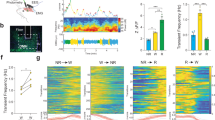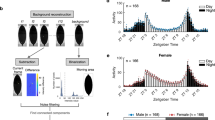Abstract
In the fruit fly, Drosophila melanogaster, rest shares features with mammalian sleep, including prolonged immobility, decreased sensory responsiveness and a homeostatic rebound after deprivation. To understand the molecular regulation of sleep-like rest, we investigated the involvement of a candidate gene, cAMP response-element binding protein (CREB). The duration of rest was inversely related to cAMP signaling and CREB activity. Acutely blocking CREB activity in transgenic flies did not affect the clock, but increased rest rebound. CREB mutants also had a prolonged and increased homeostatic rebound. In wild types, in vivo CREB activity increased after rest deprivation and remained elevated for a 72-hour recovery period. These data indicate that cAMP signaling has a non-circadian role in waking and rest homeostasis in Drosophila.
This is a preview of subscription content, access via your institution
Access options
Subscribe to this journal
Receive 12 print issues and online access
$209.00 per year
only $17.42 per issue
Buy this article
- Purchase on Springer Link
- Instant access to full article PDF
Prices may be subject to local taxes which are calculated during checkout





Similar content being viewed by others
References
Everson, C. A. & Toth, L. A. Systemic bacterial invasion induced by sleep deprivation. Am. J. Physiol. 278, R905–916 (2000).
Jewett, M. E., Dijk, D. J., Kronauer, R. E. & Dinges, D. F. Dose–response relationship between sleep duration and human psychomotor vigilance and subjective alertness. Sleep 22, 171–179 (1999).
Hendricks, J. C. et al. Rest in Drosophila is a sleep-like state. Neuron 25, 129–138 (2000).
Shaw, P. J., Cirelli, C., Greenspan, R. J. & Tononi, G. Correlates of sleep and waking in Drosophila melanogaster. Science 287, 1834–1837 (2000).
Rubin, G. M., Yandell, M. D. & Wortman, J. R. Comparative genomics of the eukaryotes. Science 287, 2204–2215 (2000).
Belvin, M. P., Zhou, H. & Yin, J. C. P. The Drosophila dCREB2 gene affects the circadian clock. Neuron 22, 777–787 (1999).
Obrietan, K., Impey, S., Smith, D., Athos, J. & Storm, D. R. Circadian regulation of cAMP response element-mediated gene expression in the suprachiasmatic nuclei. J. Biol. Chem. 274, 17748–11756 (1999).
Cirelli, C., Pompeiano, M. & Tononi, G. Neuronal gene expression in the waking state: a role for the locus coeruleus. Science 274, 1211–1215 (1996).
Zamboni, G., Perez, E., Amici, R., Jones, C. A. & Parmeggiani, P. L. Control of REM sleep: an aspect of the regulation of physiological homeostasis. Arch. Ital. Biol. 137, 249–262 (1999).
Capece, M. L. & Lydic, R. cAMP and protein kinase A modulate cholinergic rapid eye movement sleep generation. Am. J. Physiol. 273, R1430–1440 (1997).
Levine, J. D., Casey, C. L., Kalderon, D. D. & Jackson, F. R. Altered circadian pacemaker functions and cyclic AMP rhythms in the Drosophila learning mutant dunce. Neuron 13, 967–974 (1994).
Dudai, Y., Uzzan, A. & Zvi, S. Abnormal activity of adenylate cyclase in the Drosophila memory mutant rutabaga. Neurosci. Lett. 42, 207–212 (1983).
Yin, J. D. et al. A Drosophila CREB/CREM homolog encodes multiple isoforms, includng a cyclic AMP-dependent protein kinase-responsive transcriptional activator and antagonist. Mol. Cell. Biol. 15, 5123–5130 (1995).
Yin, J. C. P. et al. Induction of a dominant negative CREB transgene specifically blocks long-term memory in Drosophila. Cell 79, 49–58 (1994).
Yin, J. C., Del Vecchio, M., Zhou, H. & Tully, T. CREB as a memory modulator: induced expression of a dCREB2 activator isoform enhances long-term memory in Drosophila. Cell 81, 107–115 (1995).
Habener, J. F., Miller, C. P. & Vallego, M. cAMP-dependent regulation of gene transcription by cAMP response element-binding protein and cAMP response element modulator. Vitam. Horm. 91, 1–56 (1995).
Duman, R. S. & Vaidya, V. A. Molecular and cellular actions of chronic electroconvulsive seizures. J. ECT 14, 181–193 (1998).
Lelkes, Z., Alfoldi, P., Erdos, A. & Benedek, G. Rolipram, an antidepressant that increases the availability of cAMP, transiently enhances wakefulness in rats. Pharmacol. Biochem. Behav. 60, 835–839 (1998).
Abel, T. et al. Genetic demonstration of a role for PKA in the late phase of LTP and in hippocampal-based long-term memory. Cell 8, 615–626 (1997).
Davis, R. L. Physiology and biochemistry of Drosophila learning mutants. Physiol. Rev. 76, 299–317 (1996).
Silva, A. J., Kogan, J. H., Frankland, P. W. & Kida, S. CREB and memory. Annu. Rev. Neurosci. 21, 127–148 (1998).
Hendricks, J. C., Sehgal, A. & Pack, A. I. The need for a simple animal model to understand sleep. Prog. Neurobiol. 61, 339–351 (2000).
Naylor, E. et al. The circadian Clock mutation alters sleep homeostasis in the mouse. J. Neurosci. 20, 8138–8143 (2000).
Freeland, K., Liu, Y. Z. & Latchman, D. S. Distinct signaling pathways mediate the cAMP response element (CRE)-dependent activation of the calcitonin gene-related peptide gene promoter by cAMP and nerve growth factor. Biochem. J. 345, 233–238 (2000).
Park, S. K., Sedore, S. A., Cronmiller, C. & Hirsh, J. Type II cAMP-dependent protein kinase-deficient Drosophila are viable but show developmental, circadian, and drug response phenotype. J. Biol. Chem. 275, 20588–20596 (2000).
Eresh, S., Riese, J., Jackson, D. B., Bobmann, D. & Bienz, M. A CREB-binding site as a target for decapentaplegic signaling during Drosophila endoderm induction. EMBO J. 16, 2014–2022 (1997).
Walton, M. R. & Dragunow, I. Is CREB a key to neuronal survival? Trends Neurosci. 23, 48–53 (2000).
Nibuya, M., Nestler, E. J. & Duman, R. S. Chronic antidepressant administration increases the expression of cAMP response element binding protein (CREB) in rat hippocampus. J. Neurosci. 16, 2365–2372 (1996).
Williams, J. A., Su, H. S., Bernards, A., Field, F. & Sehgal, A. A circadian output in Drosophila mediated by Neurofibromatosis-1 and Ras/MAPK. Science 293, 2251–2256 (2001).
Kilduff, K. S. What rest in flies can tell us about sleep in mammals. Neuron 26, 295–298 (2000).
Sehgal, A. et al. Rhythmic expression of timeless: a basis for promoting circadian cycles in period gene autoregulation. Science 270, 808–811 (1995).
Plautz, J. D. et al. Quantitative analysis of Drosophila period gene transcription in living animals. J. Biol. Rhythms 12, 204–217 (1997).
Acknowledgements
This work was supported by grants (R01-HL-59649, SCOR-HL-60287) from the National Institutes of Heart, Lung and Blood (J.C.H., J.C.-P.Y.) and the Howard Hughes Medical Institute (A.S.). We thank J. Cater for biostatistical assistance and A.I. Pack for advice and support.
Author information
Authors and Affiliations
Corresponding author
Rights and permissions
About this article
Cite this article
Hendricks, J., Williams, J., Panckeri, K. et al. A non-circadian role for cAMP signaling and CREB activity in Drosophila rest homeostasis. Nat Neurosci 4, 1108–1115 (2001). https://doi.org/10.1038/nn743
Received:
Accepted:
Published:
Issue Date:
DOI: https://doi.org/10.1038/nn743
This article is cited by
-
A signalling pathway for transcriptional regulation of sleep amount in mice
Nature (2022)
-
Neurofibromin 1 in mushroom body neurons mediates circadian wake drive through activating cAMP–PKA signaling
Nature Communications (2021)
-
Sleep in honey bees is affected by the herbicide glyphosate
Scientific Reports (2020)
-
Implicit time-place conditioning alters Per2 mRNA expression selectively in striatum without shifting its circadian clocks
Scientific Reports (2018)
-
Sleep, Performance, and Memory in Flies
Current Sleep Medicine Reports (2015)



